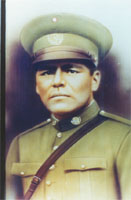|
San Bartolo Coyotepec
San Bartolo Coyotepec is a town and municipality located in the center of the Mexican state of Oaxaca. It is in the Centro District of the Valles Centrales region about fifteen km south of the capital of Oaxaca. The town is best known for its ''Barro negro pottery'' - black clay pottery. For hundreds of years pottery has been made here with a gray matte finish, but in the 1950s a technique was devised to give the pieces a shiny black finish without painting. This has made the pottery far more popular and collectable. The town is home to the Museo Estatal de Arte Popular de Oaxaca (State Museum of Popular Art of Oaxaca) which was opened here in 2004, with a large portion of its collection consisting of barro negro pottery. There is also a barro negro mural on the recently opened Baseball Academy. History The area was the settled homeland of the ancient Mesoamerican Zapotec civilization going back at least 2500 years, with the oldest archeological finds being in the Valley of O ... [...More Info...] [...Related Items...] OR: [Wikipedia] [Google] [Baidu] |
Zapotec Language
The Zapotec languages are a group of around 50 closely related indigenous Mesoamerican languages that constitute a main branch of the Oto-Manguean language family and which is spoken by the Zapotec people from the southwestern-central highlands of Mexico. A 2020 census reports nearly half a million speakers, with the majority inhabiting the state of Oaxaca. Zapotec-speaking communities are also found in the neighboring states of Puebla, Veracruz, and Guerrero. Labor migration has also brought a number of native Zapotec speakers to the United States, particularly in California and New Jersey. Most Zapotec-speaking communities are highly bilingual in Spanish. Name The name of the language in Zapotec itself varies according to the geographical variant. In Juchitán (Isthmus) it is ''Diidxazá'' , in Mitla it is ''Didxsaj'' , in Zoogocho it is ''Diža'xon'' , in Coatec Zapotec it is ''Di'zhke , in Miahuatec Zapotec it is ''Dí'zdéh'' and in Santa Catarina Quioquitani it is ''Tii ... [...More Info...] [...Related Items...] OR: [Wikipedia] [Google] [Baidu] |
Zapotec Languages
The Zapotec languages are a group of around 50 closely related indigenous languages of Mesoamerica, indigenous Mesoamerican languages that constitute a main branch of the Oto-Manguean languages, Oto-Manguean language family and which is spoken by the Zapotec people from the southwestern-central highlands of Mexico. A 2020 census reports nearly half a million speakers, with the majority inhabiting the state of Oaxaca. Zapotec-speaking communities are also found in the neighboring states of Puebla, Veracruz, and Guerrero. Human migration#Theories for migration for work in the 21st century, Labor migration has also brought a number of native Zapotec speakers to the United States, particularly in California and Bridgeton, New Jersey, New Jersey. Most Zapotec-speaking communities are highly bilingual in Spanish. Name The name of the language in Zapotec itself varies according to the geographical variant. In Juchitán (Isthmus) it is ''Diidxazá'' , in Mitla it is ''Didxsaj'' , in Zoog ... [...More Info...] [...Related Items...] OR: [Wikipedia] [Google] [Baidu] |
Spanish Conquest Of The Aztec Empire
The Spanish conquest of the Aztec Empire, also known as the Conquest of Mexico or the Spanish-Aztec War (1519–21), was one of the primary events in the Spanish colonization of the Americas. There are multiple 16th-century narratives of the events by Spanish conquistadors, their indigenous allies, and the defeated Aztecs. It was not solely a contest between a small contingent of Spaniards defeating the Aztec Empire but rather the creation of a coalition of Spanish invaders with tributaries to the Aztecs, and most especially the Aztecs' indigenous enemies and rivals. They combined forces to defeat the Mexica of Tenochtitlan over a two-year period. For the Spanish, the expedition to Mexico was part of a project of Spanish colonization of the New World after twenty-five years of permanent Spanish settlement and further exploration in the Caribbean. Significant events in the conquest of Mesoamerica Historical sources for the conquest of Mexico recount some of the same events in bot ... [...More Info...] [...Related Items...] OR: [Wikipedia] [Google] [Baidu] |
Pre-Columbian Era
In the history of the Americas, the pre-Columbian era spans from the Migration to the New World, original settlement of North and South America in the Upper Paleolithic period through European colonization of the Americas, European colonization, which began with Christopher Columbus's voyage of 1492. Usually, the era covers the history of Indigenous peoples of the Americas, Indigenous cultures until significant influence by Europeans. This may have occurred decades or even centuries after Columbus for certain cultures. Many pre-Columbian civilizations were marked by permanent settlements, cities, agriculture, civic and monumental architecture, major earthworks (archaeology), earthworks, and Complex society, complex societal hierarchies. Some of these civilizations had long faded by the time of the first permanent European colonies (c. late 16th–early 17th centuries), and are known only through archaeology of the Americas, archaeological investigations and oral history. Other civi ... [...More Info...] [...Related Items...] OR: [Wikipedia] [Google] [Baidu] |
Kiln
A kiln is a thermally insulated chamber, a type of oven, that produces temperatures sufficient to complete some process, such as hardening, drying, or chemical changes. Kilns have been used for millennia to turn objects made from clay into pottery, tiles and bricks. Various industries use rotary kilns for pyroprocessing—to calcinate ores, to calcinate limestone to lime for cement, and to transform many other materials. Pronunciation and etymology According to the Oxford English Dictionary, kiln was derived from the words cyline, cylene, cyln(e) in Old English, in turn derived from Latin ''culina'' ("kitchen"). In Middle English the word is attested as kulne, kyllne, kilne, kiln, kylle, kyll, kil, kill, keele, kiele. For over 600 years, the final "n" in kiln was silent. It wasn't until the late 20th century where the "n" began to be pronounced. This is due to a phenomenon known as spelling pronunciation, where the pronunciation of a word is surmised from its spelling an ... [...More Info...] [...Related Items...] OR: [Wikipedia] [Google] [Baidu] |
Dishware
Tableware is any dish or dishware used for setting a table, serving food, and dining. It includes cutlery, glassware, serving dishes, and other items for practical as well as decorative purposes. The quality, nature, variety and number of objects varies according to culture, religion, number of diners, cuisine and occasion. For example, Middle Eastern, Indian or Polynesian food culture and cuisine sometimes limits tableware to serving dishes, using bread or leaves as individual plates. Special occasions are usually reflected in higher quality tableware. Cutlery is more usually known as ''silverware'' or ''flatware'' in the United States, where ''cutlery'' usually means knives and related cutting instruments; elsewhere cutlery includes all the forks, spoons and other silverware items. Outside the US, ''flatware'' is a term for "open-shaped" dishware items such as plates, dishes and bowls (as opposed to "closed" shapes like jugs and vases). ''Dinnerware'' is another term use ... [...More Info...] [...Related Items...] OR: [Wikipedia] [Google] [Baidu] |
Gloss (material Appearance)
Gloss is an optical property which indicates how well a surface reflects light in a specular (mirror-like) direction. It is one of the important parameters that are used to describe the visual appearance of an object. The factors that affect gloss are the refractive index of the material, the angle of incident light and the surface topography. Apparent gloss depends on the amount of ''specular'' reflection – light reflected from the surface in an equal amount and the symmetrical angle to the one of incoming light – in comparison with ''diffuse'' reflection – the amount of light scattered into other directions. Theory When light illuminates an object, it interacts with it in a number of ways: * Absorbed within it (largely responsible for colour) * Transmitted through it (dependent on the surface transparency and opacity) * Scattered from or within it (diffuse reflection, haze and transmission) * Specularly reflected from it (gloss) Variations in surface texture directly ... [...More Info...] [...Related Items...] OR: [Wikipedia] [Google] [Baidu] |
Grey
Grey (more common in British English) or gray (more common in American English) is an intermediate color between black and white. It is a neutral or achromatic color, meaning literally that it is "without color", because it can be composed of black and white. It is the color of a cloud-covered sky, of ash and of lead. The first recorded use of ''grey'' as a color name in the English language was in 700 CE.Maerz and Paul ''A Dictionary of Color'' New York:1930 McGraw-Hill Page 196 ''Grey'' is the dominant spelling in European and Commonwealth English, while ''gray'' has been the preferred spelling in American English; both spellings are valid in both varieties of English. In Europe and North America, surveys show that grey is the color most commonly associated with neutrality, conformity, boredom, uncertainty, old age, indifference, and modesty. Only one percent of respondents chose it as their favorite color. Etymology ''Grey'' comes from the Middle English or ... [...More Info...] [...Related Items...] OR: [Wikipedia] [Google] [Baidu] |
Pottery
Pottery is the process and the products of forming vessels and other objects with clay and other ceramic materials, which are fired at high temperatures to give them a hard and durable form. Major types include earthenware, stoneware and porcelain. The place where such wares are made by a ''potter'' is also called a ''pottery'' (plural "potteries"). The definition of ''pottery'', used by the ASTM International, is "all fired ceramic wares that contain clay when formed, except technical, structural, and refractory products". In art history and archaeology, especially of ancient and prehistoric periods, "pottery" often means vessels only, and sculpted figurines of the same material are called "terracottas". Pottery is one of the oldest human inventions, originating before the Neolithic period, with ceramic objects like the Gravettian culture Venus of Dolní Věstonice figurine discovered in the Czech Republic dating back to 29,000–25,000 BC, and pottery vessels that were ... [...More Info...] [...Related Items...] OR: [Wikipedia] [Google] [Baidu] |
Community
A community is a social unit (a group of living things) with commonality such as place, norms, religion, values, customs, or identity. Communities may share a sense of place situated in a given geographical area (e.g. a country, village, town, or neighbourhood) or in virtual space through communication platforms. Durable good relations that extend beyond immediate genealogical ties also define a sense of community, important to their identity, practice, and roles in social institutions such as family, home, work, government, society, or humanity at large. Although communities are usually small relative to personal social ties, "community" may also refer to large group affiliations such as national communities, international communities, and virtual communities. The English-language word "community" derives from the Old French ''comuneté'' (Modern French: ''communauté''), which comes from the Latin ''communitas'' "community", "public spirit" (from Latin '' communis'', "co ... [...More Info...] [...Related Items...] OR: [Wikipedia] [Google] [Baidu] |
Zapotec Peoples
The Zapotecs ( Valley Zapotec: ''Bën za'') are an indigenous people of Mexico. The population is concentrated in the southern state of Oaxaca, but Zapotec communities also exist in neighboring states. The present-day population is estimated at approximately 400,000 to 650,000 persons, many of whom are monolingual in one of the native Zapotec languages and dialects. In pre-Columbian times, the Zapotec civilization was one of the highly developed cultures of Mesoamerica, which, among other things, included a system of writing. Many people of Zapotec ancestry have emigrated to the United States over several decades, and they maintain their own social organizations in the Los Angeles and Central Valley areas of California. There are four basic groups of Zapotecs: the ', who live in the southern Isthmus of Tehuantepec, the ', who live in the northern mountains of the Sierra Madre de Oaxaca, the southern Zapotecs, who live in the southern mountains of the Sierra Sur, and the Central Va ... [...More Info...] [...Related Items...] OR: [Wikipedia] [Google] [Baidu] |






